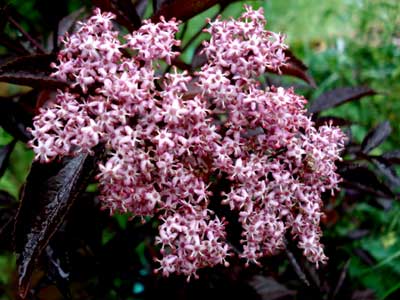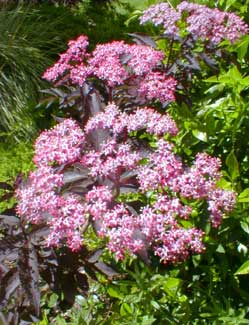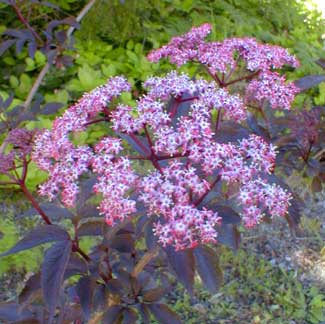
"Black Beauty 'Gerda'"
Black Elderberry
"The cured wound
opens inwards to a dark
elderberry place"
-Seamus Heaney
(b. 1939)
(b. 1939)
 The black elderberry cultivar 'Gerda' is sold under the trademark name 'Black Beauty' or as "Black Beauty 'Gerda.'" It swiftly became the standard purple-leaf form of Sambucus nigra in the nursery trade, though for decades prior to its 2003 introduction, the standard cultivar was 'Purpurea,' which we also have.
The black elderberry cultivar 'Gerda' is sold under the trademark name 'Black Beauty' or as "Black Beauty 'Gerda.'" It swiftly became the standard purple-leaf form of Sambucus nigra in the nursery trade, though for decades prior to its 2003 introduction, the standard cultivar was 'Purpurea,' which we also have.The leaf color on 'Purpurea' changed from purple-black in spring to olive-green in summer to red in autumn. It had a competitor called 'Guincho Purple' which was touted as an improvement over 'Purpurea,' but the glowy claims for it were exaggerated & it never really displaced 'Purpurea' as the popular choice.
'Guincho Purple' originated in a garden called Guincho in Northern Ireland, & although it was reputed to stay purple longer into summer, they were in fact so similar that the names were soon interchangeable in the trade. So if they're really distinct cultivars, there's even so no certainty of which you're getting no matter which name is attached, & several nurseries & arboretums were convinced they were never sufficiently distinct to be anything but synonymous.
 But a genuine improvement for long-lasting purple eventually appeared. It was "Black Beauty 'Gerda'" developed by Ken Tobutt & Jacqui Prevette at the Horticulture Research International (HRI) site at East Malling, England. It was launched commercially between 2000 & 2002, & by 2005 'Purpurea' had been discontinued by the majority of growers to make room to produce more & more of 'Black Beauty.'
But a genuine improvement for long-lasting purple eventually appeared. It was "Black Beauty 'Gerda'" developed by Ken Tobutt & Jacqui Prevette at the Horticulture Research International (HRI) site at East Malling, England. It was launched commercially between 2000 & 2002, & by 2005 'Purpurea' had been discontinued by the majority of growers to make room to produce more & more of 'Black Beauty.'Personally I greatlty like 'Purpurea' & am sorry to see it becoming a scarser shrub in the marketplace. The fact that it changes in every season is not to me a negative factor, but renders the shrub antic & interesting, distinct in every season. I think 'Purpurea' should have remained popularly available, as it is good to have two different cultivars planted near one another since cross-pollinating increases fruit size or production.
But it is definitely true that 'Black Beauty' stays dark-leafed in summer. It is such dark purple it is almost black.
Its little pink buds grow larger & larger throughout spring until by early May they have become huge ten-inch wide cymes of pink buds that before month's end open into big clusters of teency pink starflowers attractive to butterflies, in full flourish for June.
It is at this time the really wonderful "extra" provided by 'Black Beauty' becomes obvious: the blossoms have a lovely citrusy odor. Other cultivars of S. nigra have an indifferent scent or none at all, but here are the same gorgeous racemes with lovely perfume.
The cymes of blossoms become large clusters of berries that ripen to black by late summer. These are bitter easten fresh from the shrub, but when cooked, sieved, & sweetened make excellent jellies & syrups, & are famous for home winemaking. If not harvested they serve to attract birds.
It can grow to be ten by ten feet huge or even fifteen feet, plus it can spread by suckering to colonize an increasingly wide area. It can be left to grow large & wild, or it can be sheared & have suckers removed periodically in order to keep it to a medium size. If it is "coppiced" every third year it will remain very leafy & compact; coppicing means to cut it back nearly to the ground to let it start over, & to keep it from ever becoming an especially huge shrub.
Adaptable in the garden, this recipient of the Award of Garden Merit tolerates damp to somewhat droughty conditions (though moist well draining humusy soil is best), in full sun or partial shade (though leaf color is best in full sun), in USDA zones 4 through 8.
See also
The Mythology of Black Elderberry.
& see the
'Purpurea' Elderberry page of the Berries Gallery
as well as the
Main Sambucus nigra 'Purpurea' page
not the mention the
Sambucus racemosa pubens Pacific Red Elderberry
or the fancy
Sambucus racemosa 'Sutherland Golden'
The Mythology of Black Elderberry.
& see the
'Purpurea' Elderberry page of the Berries Gallery
as well as the
Main Sambucus nigra 'Purpurea' page
not the mention the
Sambucus racemosa pubens Pacific Red Elderberry
or the fancy
Sambucus racemosa 'Sutherland Golden'